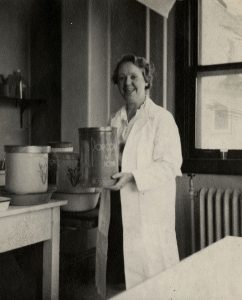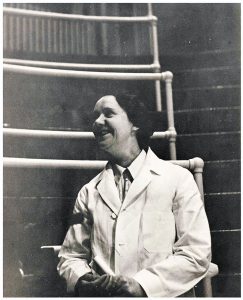
Margaret Gladys Smith, MD, was the first woman to head a department at Washington University School of Medicine, serving as the de facto chair of the Department of Pathology after the sudden death of Howard A. McCordock, MD, in November 1938. Until the appointment of a new chair in July 1939, Smith led the department while continuing her own research. She had become nationally prominent in the early 1930s for her research on the virus which causes St. Louis encephalitis.
Smith earned a medical degree from Johns Hopkins University in 1922 and in 1926 joined Washington University as an assistant professor of pathology. Smith asked her male colleagues what they would expect as a salary, not what she, as a woman should expect. Initially offered a lower number, she negotiated for moving expenses and a pay increase for her second year.
Her initial interest in pathology came during her years in medical school. Returning from Christmas break in 1918 (during the worldwide influenza pandemic) she saw dozens of pine coffins lined up outside of Johns Hopkins’ pathology department. She devoted most of her career to investigating viruses.

Unlike bacteria, which can grow in a laboratory environment within a simple growth medium, viruses require living cells to infect before reproducing. After infecting a cell, the virus uses the cell’s own components to produce more copies of itself. However, many viruses cannot thrive without having a specific, or homologous, tissue to infect. For instance, HIV (or Human Immunodeficiency Virus) is a type of virus which does not infect small mammals, like mice, rats, or rabbits, typically used in research on viruses. The St. Louis encephalitis virus (SLEV) cycles through mosquito and bird populations, though humans and domestic mammals can also be infected by SLEV making it a relatively easy virus to study.
Smith’s investigation into salivary gland virus, known to us today as cytomegalovirus (CMV), was difficult at first. Fortunately, in 1949 researchers in Boston (Thomas Weller and Frederick Robbins in the laboratory of John Enders) developed techniques to study viruses which needed live human cells to infect. Smith was in correspondence with them and visited their lab. In 1953, using these new techniques she first succeeded in isolating a mouse variant of the cytomegalovirus from the salivary glands of mice – a strain named for her and still used in research. She and her lab assistants were then able to do the same with a human variant found in tissue samples of an infant who had died of an adrenal carcinoma. In 1954 Smith submitted two papers for the mouse and human viruses; however, her paper on the human virus was rejected by the journal’s editors. They thought she must have contaminated the human cells with the mouse virus despite her carefully noting that “the human agent does not produce lesions in mouse tissue or the mouse one in human tissue.” She was also the first to recognize the host species-specificity of cytomegaloviruses. Her pioneering work in identifying cytomegaloviruses was eventually recognized.
At Washington University, Smith forged strong ties between the Department of Pathology and St. Louis Children’s Hospital and was made a full professor of pathology in 1957. She is considered one of the founders of pediatric pathology in the United States.
In 1958, the St. Louis Globe-Democrat newspaper named Smith one of the Women of Achievement because of her contributions to science. In 1964, she was honored at the Washington University Founder’s Day ceremonies. At the end of that academic year, Smith officially retired, though as professor emerita, she co-authored the classic textbook “Pathology of Infancy and Childhood” with John M. Kissane. Smith died in 1970.
In honor of her achievements and in recognition of her dedication to women in medicine, the School of Medicine established the Margaret G. Smith Award to be given to a female student for outstanding achievement in the first two years of medical school.



